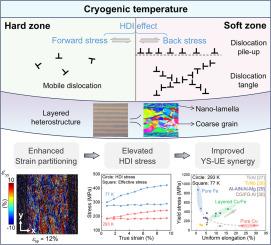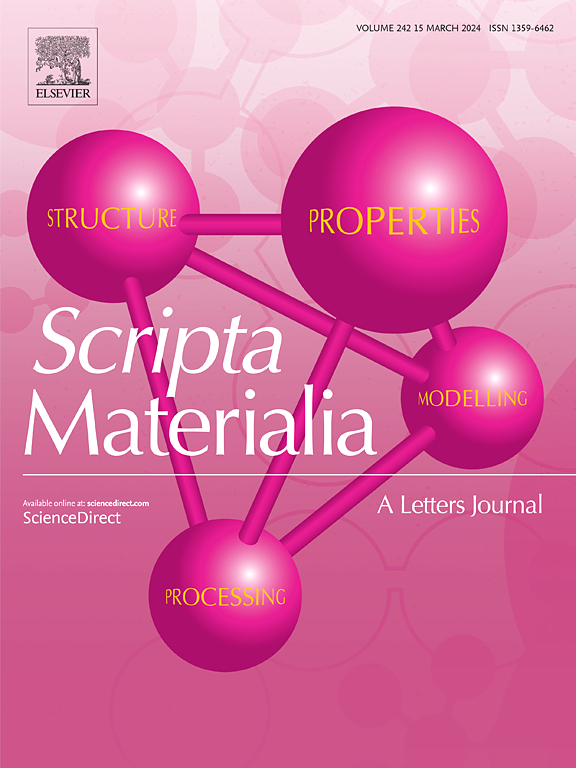低温放大的HDI效应增强了层状异质结构的强度-延性协同作用
IF 5.6
2区 材料科学
Q2 MATERIALS SCIENCE, MULTIDISCIPLINARY
引用次数: 0
摘要
异质变形诱导(HDI)硬化效应是克服异质结构金属强度-延性平衡的关键;然而,它在低温下的行为尚不清楚。在这里,我们研究了层状Cu/Fe样品在293 K和77 K下的力学响应,揭示了77 K下强度和延展性之间的协同作用的显著增强。加载-卸载-再加载(LUR)试验表明,在低温下,鲍辛格效应更强,HDI应力水平更高。微观表征表明,在异质区边界附近,应变分配加剧,几何上必需的位错(GND)积累增加,这归因于Cu和Fe之间更大的屈服强度不匹配。晶体塑性有限元(CPFE)模拟进一步捕捉到77 K时应变分配增强、GND密度升高和背应力增加,与实验结果一致。这些发现表明,低温条件显著放大了HDI效应,为设计适合先进低温应用的异质结构材料提供了有价值的见解。本文章由计算机程序翻译,如有差异,请以英文原文为准。

Cryogenic amplification of the HDI effect enhances strength-ductility synergy in layered heterostructures
The hetero-deformation-induced (HDI) hardening effect is crucial for overcoming the strength-ductility trade-off in heterostructured metals; however, its behavior at cryogenic temperatures remains unclear. Here, we examine the mechanical response of layered Cu/Fe samples at 293 K and 77 K, revealing a substantial enhancement in the synergy between strength and ductility at 77 K. Loading-unloading-reloading (LUR) tests indicate a stronger Bauschinger effect and a higher level of HDI stress at the cryogenic temperature. Microscopic characterizations reveal intensified strain partitioning and increased geometrically necessary dislocation (GND) accumulation near hetero-zone boundaries, which is attributed to a greater yield strength mismatch between Cu and Fe. Crystal plasticity finite element (CPFE) simulations further capture the enhanced strain partitioning, elevated GND density, and increased back stress at 77 K, consistent with experimental results. These findings demonstrate that cryogenic conditions significantly amplify the HDI effect, providing valuable insights for designing heterostructured materials suited for advanced cryogenic applications.
求助全文
通过发布文献求助,成功后即可免费获取论文全文。
去求助
来源期刊

Scripta Materialia
工程技术-材料科学:综合
CiteScore
11.40
自引率
5.00%
发文量
581
审稿时长
34 days
期刊介绍:
Scripta Materialia is a LETTERS journal of Acta Materialia, providing a forum for the rapid publication of short communications on the relationship between the structure and the properties of inorganic materials. The emphasis is on originality rather than incremental research. Short reports on the development of materials with novel or substantially improved properties are also welcomed. Emphasis is on either the functional or mechanical behavior of metals, ceramics and semiconductors at all length scales.
 求助内容:
求助内容: 应助结果提醒方式:
应助结果提醒方式:


